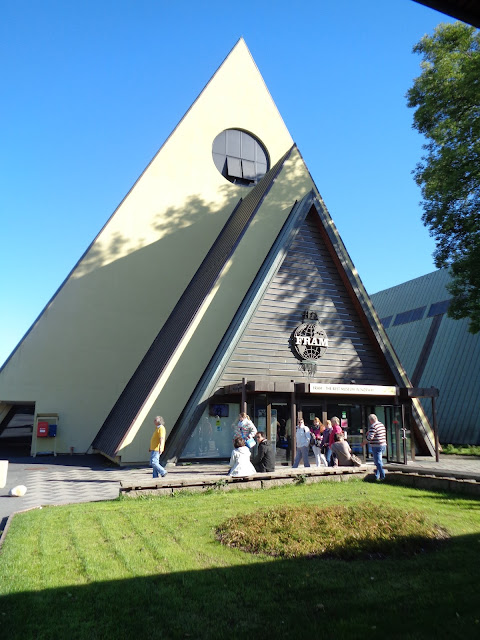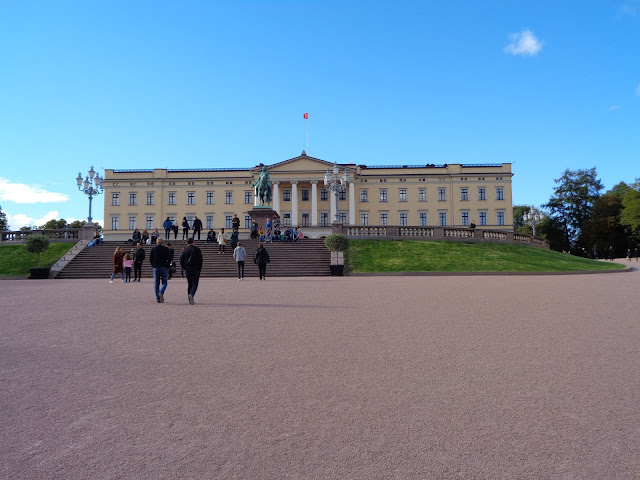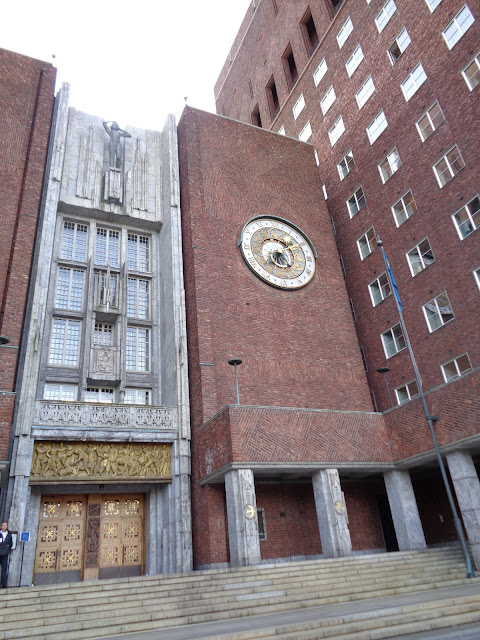“Are you sure you know how to get to the
airport?” Ryan questions with a note of concern. It’s Friday late-morning and I
have a flight leaving from Schipol airport at 3pm. Up to this point, he’s heard
my misadventures that frequently feature me getting hopelessly lost despite
having a detailed map and GPS on my phone. This time, I am flying to Oslo,
Norway to spend the weekend as PhD student-Kayla: the perma-student asking
questions, observing, and feeding my curious brain with culture and history.
“Mind now…dare say I’ll manage,” answers
silly-Kayla: the overly confident globetrotter already scheming which song to
sing over the weekend.
With my trusty OV-chip card in my hand and
Lana Del Rey’s latest album crooning through my headphones, I take off for the
airport. Within 45 minutes, I am through security and patiently waiting at my
gate. The flight is surprisingly quick and pleasant; after seeing me read F.
Scott Fitzgerald’s Tender Is The Night,
my seat companion passes our time together by telling me her father attended
dance school with my beloved author many years ago. By 5pm when I’m desperately
calibrating to my new surroundings, I’m again reminded of how small our world
really is; turns out my seatmate has been to L’anse aux Meadows and is visiting
Oslo to see the Viking Ship Museum. We laugh that, like the Vikings, we’re also
adventurers and explorers. Though we agree that perhaps we’re a little less
violent J
Back in June, myself and the Dept of
Folklore’s visiting professor, Dr. Michael Lange, headed to the Northern
Peninsula to visit LAM and to clue up some fieldwork for my MA thesis. As I’ve
noted in an earlier blog post, my PhD research will focus on LAM and how its historical
significance has changed the community (both in tangible and intangible ways)
in the last fifty years. Mike and I spent the day exploring the site at LAM,
myself mainly as a local “seeing” the site through his critical eye. While
chatting with my old colleague, Clayton Colbourne, we flipped through an
incredible book of photographs taken at the time of the excavations. Clayt
explained that the book was gifted by Nicolay Eckhoff, a Norweigan who had
worked at the site during four of the Ingstad excavations in the 1960s.
Thrilled to learn that Mr. Eckhoff lives in Oslo, I followed Clayt’s advice and
got his contact info from Hilary Patey—granddaughter of Lloyd and Madge Decker,
a family Nicolay has remained closed to all these years. Nicolay agreed to meet
with me upon my arrival in Oslo, and graciously invited me for dinner on my first night in
the city.
Clayt & I: we first met in 2007 when I was hired at the giftshop in LAM
And so I found myself Friday afternoon
taking the subway’s Line 1 to Frognerseteren West to meet Nicolay at his home.
I was a little nervous as I walked along his street, as I so often am when
meeting an interviewee for the first time. My nerves were certainly misplaced
this time, though. As soon as Nicolay opened the door, I was so warmly welcomed
that I felt as though there was no other place in Oslo I should have been at
that moment. Nicolay and I had an insightful chat for an hour or so, during
which he shared some very interesting stories about his time in LAM as well as
other information about his life afterwards. It was fascinating to hear about
how the community that, during my lifetime, has always been an area of much
tourism, was very isolated when Nicolay first arrived in 1963. He has seen
firsthand how many of the community’s changes—the introduction of roads, indoor
plumbing, the site receiving UNESCO designation and opening to the public, the
cod moratorium, etc.—were adapted to. It was also truly lovely to hear Nicolay
recount his fondest memories of his time there, particularly his adventures
with his new friends, as well as his impressions of the place as an outsider.
My rumbling tummy reminding me that the
“savoury snack” I enjoyed on the airplane was hours ago, I was relieved when
Nicolay’s beautiful wife, Jessie, invited us to the dinnertable. The rest of
the evening was spent pleasantly enjoying the company of my gracious hosts. After
dinner, we discussed my plans for my stay in Oslo, and I appreciated their
suggestions and advice. By the time I arrived at the Anker Hotel—my modest
accommodations for the weekend—I felt prepared to take the city by storm.
Saturday morning, I awoke energized and
excited for the day ahead. After talking with Jessie and Nicolay, I decided to
buy a 72-hour Oslo Pass which offers free admission to more than 30 museums,
free public transport, and discounts.
And Museum it up, I did!
Very cool museum located on the Bygdoy Peninsula which holds the world's best preserved Viking ships, as well as artifacts from burial ships unearthed at Oseberg, Gokstad, Tune and Borre near the Oslo Fjord. According to their pamphlet, "Before these ships were drawn ashore and used as burial ships, studies show that they were used as ocean-going vessels. When the ships were buried in the burial mound, the dead were buried in a separate burial chamber in the ship, where they were well-equipped for the afterlife."
The Oseberg Ship: Built c.820AD. Used in 834AD as a burial ship for two powerful women
Burial chamber and small boats from the Gokstad burial mound
A fascinating museum, also on the Bygdoy Peninsula, displays how people lived throughout Norway from 1500 to today. Features an open-air museum, large indoor exhibits, with the highlight being the 13th century Stave Church
A faculty under the University of Oslo. Several great collections, including my personal favourite on medieval church art
Me and me Viking buddy
Contains the country's most extensive collections of art, architecture and design, as well as some of the more recognizable works by Norwegian painter Edvard Munch. I spent little time here unfortunately due to my inability to convert the NOK to CAD. At the previous museum, I fell in love with a ring that, in my estimation, would have cost me about 20 euros. Halfway through the National Gallery's impressive Munch collection, I connected to the Museum wifi to discover that the ring had actually cost 200 euros. With my financial advisor's voice in my head, I weighed up what was worth more: my ego or my $300. Finally, I ran back to the Historical Museum, received not one but two lectures about my responsibility to convert to my own currency prior to buying, and finally, got my money back. Phew! Nonetheless, a couple snaps from the National Gallery:
Madonna, 1894-95
The Scream, 1893. Also, my expression when I realized how much the piece of jewellery had cost me
20 euros vs. 200 euros
The Nobel Peace Centre:
This public showcase of the famous Peace Prize only opened in 2005, despite the fact that the annual ceremony has been held in this city since 1901.
The Kon Tiki Museum:
Thor Heyerdahl gained worldwide fame when he crossed the Pacific Ocean on the balsawood raft Kon-Tiki in 1947. The museum displays the original vessels and exhibits on Heyerdahl's expeditions.

The Fram Museum:
This spot houses one of the world's most famous polar exploration ships.
Are you as museum-ed out as I am, dear reader? Even spread out over three days, this was an ambitious feat! Of course, I spent a lot of time wandering through the city centre and enjoying the vibe of what is definitely one cool city.
The view from my mini-cruise
The Royal Palace
Oslo Cathedral
The National Gallery
Opera House
Oslo City Hall, where the Nobel Peace Prize is awarded
The Grand Hotel
"Angry Baby" at Vigeland Park
And, of course, I managed to find the time to embarrass myself by singing into my phone.
Oh, and trolls. Did I mention those?
I felt a bit run down and ragged, not unlike my troll buddy, by the time my short stay in Oslo wound down. One delayed flight later, I was back in Amsterdam on Monday night, physically tired but mentally recharged after engaging with a fascinating historical culture and contemporary city in the core of Scandinavia. Stay tuned!
xo
kc



























































